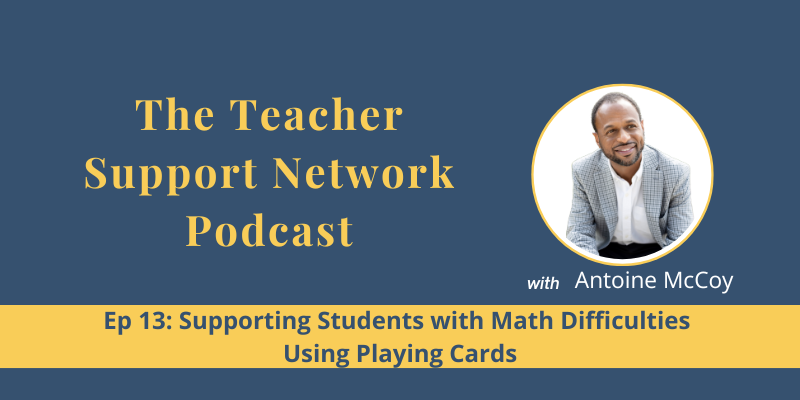
In this episode ~
In this episode of the Teacher Support Network podcast, we discuss the usage of playing cards as an effective and engaging tool for helping students with math difficulties.
Listen in as we uncover how playing cards can support number recognition, basic operations, and reinforce math facts. We also share ideas for incorporating playing cards to teach more advanced concepts such as integers, fractions, and probability.
Listen in~
00:06 The Power of Playing Cards in Math Education
01:00 Using Playing Cards for Number Recognition and Counting
01:37 Reinforcing Math Facts with Card Games
02:53 Advanced Math Concepts with Playing Cards
04:34 Conclusion and Call to Action
Useful Resources:
Free Download Gen Ed & SpEd Teachers Collaborative Conversations Guide here.
Join my Newsletter for a weekly dose of practical strategies, tips, resources and inspiration to support you on your teaching journey here.
Transcript
Hey Teachers. Welcome to this week's episode of the Teacher Support Network podcast. I'm your host Antoine McCoy and today we're talking about a simple, but powerful everyday resource that can help students who have math difficulties and challenges in your classroom.
So what tool am I referring to? I'm talking about playing cards.
You know the cards you get from the department store. So, why playing cards? Well, first, they're easily accessible, they're affordable, and let's be honest, who doesn't love a good card game, right? And the best part is, they make learning feel like play, which is exactly what students who struggle with math or have math anxiety need.
Playing cards helps take away the overwhelm and just makes it more accessible for them. So let's dive into some fun, effective ways to use playing cards in a classroom with your students in school and even at home with your own kids.
First, playing cards can really help support number recognition and counting.
So when you think about younger students just recognizing numbers and learning to count can be a challenge. So one easy activity is simply laying out the playing cards and having kids put them in numerical order. You can also take those same playing cards and have them practice skip counting by twos and by fives and by tens, using only certain suits of the cards.
It's just a real fun and hands-on way to reinforce numbers for younger students.
Second, playing cards can really help students practice basic operations and reinforce math facts through intentional card games. One simple game is addition war. In Addition War, each player flips over two cards, they add the numbers together, and the player with the highest sum wins the round. Multiplication War was always a student favorite in my classroom. Instead of adding, students would just multiply the two cards, and whoever has the highest product wins.
These games are simple, yet they really help build quick recall of basic math facts that are needed to help engage in more complex math problems that will usually involve higher order thinking.
In addition, it will help them with math vocabulary in the classroom as well. In these games I just spoke about, they answer by saying, “the sum is,” so thinking about addition, or “the product is”, thinking about multiplication.
So there you have practice solidifying math vocabulary as they're practicing and reinforcing those math facts.
You can even use card games for older students in middle school and high school to practice more advanced concepts. For instance, when I taught an Algebra readiness class at the high school level, I used playing cards to help my students practice adding, subtracting, and multiplying integers by making an integer war game.
And it's similar to the addition and multiplication war game that I just talked about. All I did was modify things a bit and made the positive numbers the black cards and all the negative numbers the red cards. That one little shift can engage your older students who may have a learning disability, some difficulties in math, or even students who just simply have math anxiety.
Playing cards can be used for practicing and reinforcing more advanced, abstract concepts too, like fractions and probability. So for instance, an activity you can do is you can have one student draw two cards and make a fraction. Then their partner draws another two cards and they make a fraction. Then they compare the two fractions they have to see which one is larger or to see which one is smaller.
You can also use a deck of cards to teach probability by asking students simple questions like, “what's the chance or probability of drawing a red card from the deck?” “What's the chance or probability of drawing a face card,” and so forth. You get what I'm saying, right?
These specific hands-on activities using playing cards really make some of those abstract math concepts a bit more concrete and easier for students to grasp.
So there you have it. Playing cards aren't just for blackjack or poker night.
They are a fantastic, engaging way to support students who have math difficulties and really struggle with math. So give a few of these activities a try in your classroom or even at home with your own kids. Let me know how it works out for you and for the kids.
If you have any fun ways that you use playing cards in your classroom to support specific math concepts, let me know as well.
You can drop them in the comments section on the show notes page for this episode. I'll be looking forward to seeing what you have to say about what you do in your classroom as well.
So if you enjoyed this episode, please share it with a fellow educator and please check out our resources on the show notes page for this episode.
That's it for now. Thanks for tuning in. Happy teaching!
Rate, Review, & Subscribe on Apple Podcasts
Enjoy this episode?
Please consider rating and reviewing the podcast! Your support helps me support more teachers - just like you - create inclusive classrooms, foster effective teacher collaboration, and find balance with the demands of teaching in and outside of the classroom
It's easy! Click here, scroll to the bottom, tap to rate with five stars, and select "Write a Review." I'd love to know what was the most helpful or encouraging about the episode!
While you're there, you can subscribe to the podcast if you haven't already. If you're not subscribed, you may very well miss out on future episodes. 🙂 Subscribe now!


